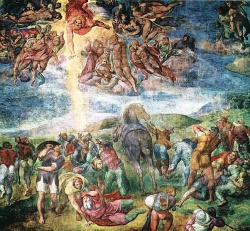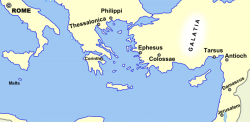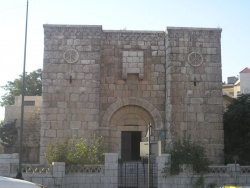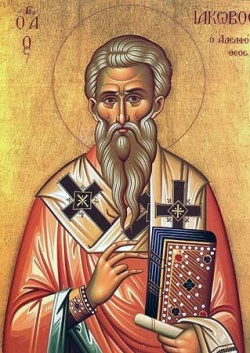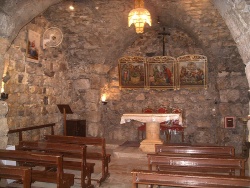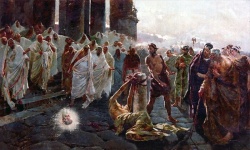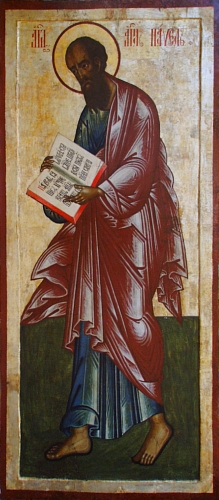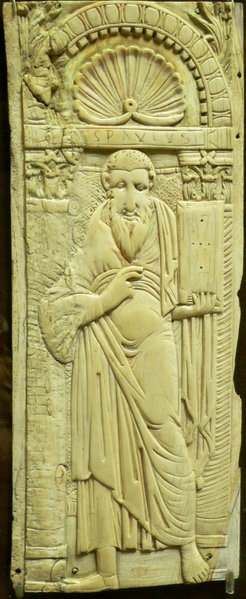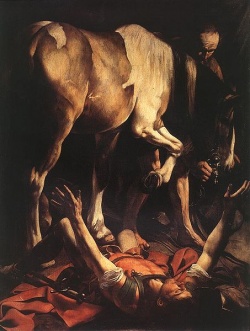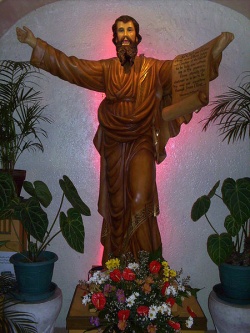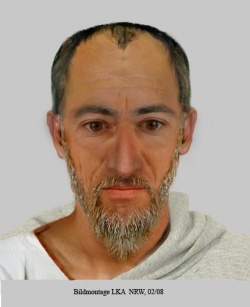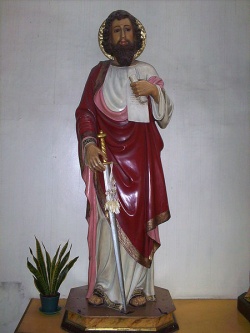St. Paul the Apostle
From Textus Receptus
(→Writings) |
Current revision (11:55, 8 March 2016) (view source) |
||
| (2 intermediate revisions not shown.) | |||
| Line 47: | Line 47: | ||
Most scholars agree that a vital meeting between Paul and the Jerusalem church took place in AD 49 or 50,<sup>[6]</sup> described in Acts 15:2 and usually seen as the same event mentioned by Paul in Galatians 2:1.<sup>[6]</sup> The key question raised was whether Gentile converts needed to be circumcised.<sup>[21]</sup> At this meeting, Peter, James, and John accepted Paul's mission to the Gentiles. See also Circumcision controversy in early Christianity. | Most scholars agree that a vital meeting between Paul and the Jerusalem church took place in AD 49 or 50,<sup>[6]</sup> described in Acts 15:2 and usually seen as the same event mentioned by Paul in Galatians 2:1.<sup>[6]</sup> The key question raised was whether Gentile converts needed to be circumcised.<sup>[21]</sup> At this meeting, Peter, James, and John accepted Paul's mission to the Gentiles. See also Circumcision controversy in early Christianity. | ||
| - | Jerusalem meetings are mentioned in Acts, in Paul's letters, and some appear in both.<sup>[22]</sup> For example, the Jerusalem visit for famine relief<sup>[Acts 11:27–30]</sup> apparently corresponds to the "first visit" (to Cephas and James only).<sup>[Gal. 1:18–20]</sup>[22] F. F. Bruce suggested that the "fourteen years" could be from Paul's conversion rather than the first visit to Jerusalem.<sup>[23]</sup> | + | Jerusalem meetings are mentioned in Acts, in Paul's letters, and some appear in both.<sup>[22]</sup> For example, the Jerusalem visit for famine relief<sup>[Acts 11:27–30]</sup> apparently corresponds to the "first visit" (to Cephas and James only).<sup>[Gal. 1:18–20]</sup><sup>[22]</sup> F. F. Bruce suggested that the "fourteen years" could be from Paul's conversion rather than the first visit to Jerusalem.<sup>[23]</sup> |
'''Incident at Antioch''' | '''Incident at Antioch''' | ||
| Line 55: | Line 55: | ||
Writing later of the incident, Paul recounts: "I opposed <sup>[Peter]</sup> to his face, because he was clearly in the wrong". Paul reports that he told Peter: "You are a Jew, yet you live like a Gentile and not like a Jew. How is it, then, that you force Gentiles to follow Jewish customs?"<sup>[Gal. 2:11–14]</sup> Paul also mentions that even Barnabas (his traveling companion and fellow apostle until that time) sided with Peter.<sup>[25]</sup> | Writing later of the incident, Paul recounts: "I opposed <sup>[Peter]</sup> to his face, because he was clearly in the wrong". Paul reports that he told Peter: "You are a Jew, yet you live like a Gentile and not like a Jew. How is it, then, that you force Gentiles to follow Jewish customs?"<sup>[Gal. 2:11–14]</sup> Paul also mentions that even Barnabas (his traveling companion and fellow apostle until that time) sided with Peter.<sup>[25]</sup> | ||
| - | The final outcome of the incident remains uncertain. The Catholic Encyclopedia states: "St. Paul's account of the incident leaves no doubt that St. Peter saw the justice of the rebuke." In contrast, L. Michael White's From Jesus to Christianity claims: "The blowup with Peter was a total failure of political bravado, and Paul soon left Antioch as persona non grata, never again to return."[26] | + | The final outcome of the incident remains uncertain. The Catholic Encyclopedia states: "St. Paul's account of the incident leaves no doubt that St. Peter saw the justice of the rebuke." In contrast, L. Michael White's From Jesus to Christianity claims: "The blowup with Peter was a total failure of political bravado, and Paul soon left Antioch as persona non grata, never again to return."<sup>[26]</sup> |
The primary source for the Incident at Antioch is Paul's letter to the Galatians. | The primary source for the Incident at Antioch is Paul's letter to the Galatians. | ||
| Line 128: | Line 128: | ||
::::<sup>13</sup>For Adam was first formed, then Eve. | ::::<sup>13</sup>For Adam was first formed, then Eve. | ||
::::<sup>14</sup>And Adam was not deceived, but the woman being deceived was in the transgression. | ::::<sup>14</sup>And Adam was not deceived, but the woman being deceived was in the transgression. | ||
| - | :::::::::::::[[1 Timothy 2]]:11-14 [[King James Version|KJV]] | + | ::::::::::::::[[1 Timothy 2]]:11-14 [[King James Version|KJV]] |
When the KJV translation of this passage is understood literally, the passage seems to be saying that women are second-class citizens at every level.<sup>[46]</sup> However, any interpretation of this portion of Scripture must wrestle with the theological, contextual, syntactical, and lexical difficulties embedded within these few words.<sup>[47]</sup> Fuller Seminary theologian J. R. Daniel Kirk finds evidence in Paul’s letters of a much more inclusive view of women. He writes that Romans 16 is a tremendously important witness to the important role of women in the early church. Paul praises Phoebe for her work as a deacon and Junia who was an apostle. Kirk points to recent studies that have led "many scholars" to conclude that the passage in 1 Corinthians 14 excluding women’s participation in worship was a later addition, apparently by a different author, and not part of Paul’s original letter to Corinth. His third example is Galatians 3:28, “in Christ Jesus there is no longer Jew and Greek, slave and free, male and female.” In pronouncing an end within the church to the divisions which are common in the world around it. He concludes by highlighting the fact that "despite what 1 Timothy commands, there were New Testament women who taught and had authority in the early churches, that this teaching and authority was sanctioned by Paul, and that Paul himself offers a theological paradigm within which overcoming the subjugation of women is an anticipated outcome."<sup>[48]</sup> | When the KJV translation of this passage is understood literally, the passage seems to be saying that women are second-class citizens at every level.<sup>[46]</sup> However, any interpretation of this portion of Scripture must wrestle with the theological, contextual, syntactical, and lexical difficulties embedded within these few words.<sup>[47]</sup> Fuller Seminary theologian J. R. Daniel Kirk finds evidence in Paul’s letters of a much more inclusive view of women. He writes that Romans 16 is a tremendously important witness to the important role of women in the early church. Paul praises Phoebe for her work as a deacon and Junia who was an apostle. Kirk points to recent studies that have led "many scholars" to conclude that the passage in 1 Corinthians 14 excluding women’s participation in worship was a later addition, apparently by a different author, and not part of Paul’s original letter to Corinth. His third example is Galatians 3:28, “in Christ Jesus there is no longer Jew and Greek, slave and free, male and female.” In pronouncing an end within the church to the divisions which are common in the world around it. He concludes by highlighting the fact that "despite what 1 Timothy commands, there were New Testament women who taught and had authority in the early churches, that this teaching and authority was sanctioned by Paul, and that Paul himself offers a theological paradigm within which overcoming the subjugation of women is an anticipated outcome."<sup>[48]</sup> | ||
| Line 319: | Line 319: | ||
* [http://spindleworks.com/library/rfaber/aratus.htm The Apostle and the Poet: Paul and Aratus] Dr. Riemer Faber | * [http://spindleworks.com/library/rfaber/aratus.htm The Apostle and the Poet: Paul and Aratus] Dr. Riemer Faber | ||
* [http://www.parsagard.com/shipwreck.htm The Apostle Paul's Shipwreck: An Historical Examination of Acts 27 and 28] | * [http://www.parsagard.com/shipwreck.htm The Apostle Paul's Shipwreck: An Historical Examination of Acts 27 and 28] | ||
| + | |||
| + | {{Donate}} | ||
Current revision
Paul of Tarsus, also called Paul the Apostle, the Apostle Paul, or Saint Paul, (Ancient Greek Σαούλ (Saul), Σαῦλος (Saulos), and Παῦλος (Paulos); Latin: Paulus or Paullus; Hebrew: שאול התרסי Šaʾul HaTarsi (Saul of Tarsus)[2] (c.5 BC - c.67 AD),[1] was a Hellenistic Jew[3] who called himself the "Apostle to the Gentiles" and is considered the Founder of Modern Christianity. Together with Saint Peter and James the Just, he is also the most notable of early Christian missionaries.[4]
According to the Acts of the Apostles, his conversion took place on the road to Damascus. Thirteen epistles in the New Testament are attributed to Paul, though authorship of six of the thirteen is questioned by some scholars.[5] Paul's influence on Christian thinking arguably has been more significant than any other New Testament author.[5]
Contents |
Sources of information
The Book of Acts contains an account of Paul's travels and deeds, his conflicts with pagans and Jews, and his interactions with the other apostles. It was written from a perspective of reconciliation between Pauline Christians and their opponents, and portrays Paul as a law-abiding Jewish Christian and omits his dispute with Peter. A primary source for historical information about Paul's life is the material found in his seven letters. However, these letters contain comparatively little information about Paul's past. It is worth noting that Acts leaves several parts of Paul's life out of its narrative, such as his execution in Rome.[6]
Scholars such as Hans Conzelmann and 20th century theologian John Knox (not the 16th century John Knox) dispute the historical reliability of Acts.[7][8] Paul's own account of his background is found particularly in Galatians. According to some scholars, the account in Acts of Paul visiting Jerusalem[Acts 11:27-30] contradicts the account in Paul's letters.[6] (Please see the full discussion in Acts of the Apostles). Most scholars[who?] consider Paul's accounts more reliable than those found in Acts.[9]
Prior to conversion
Paul, whose earlier Hebrew name was Saul,[10] was "of the stock of Israel, of the tribe of Benjamin, a Hebrew of the Hebrews; as touching the law, a Pharisee.”[Phil. 3:5] Acts identifies Paul as from Mediterranean city of Tarsus (in present-day south-central Turkey), well-known for its intellectual environment. Acts also claims Paul said he was "a Pharisee, the son of a Pharisee".[Acts 23:6]
According to his own testimony, Paul “violently persecuted” the “church of God” (followers of Jesus) prior to his conversion to Christianity.[11] and was advancing in stature within Judaism's Jerusalem temple leadership before he came to believe that the crucified Jesus, of the line of David, was actually Lord. [Rom. 1:3] Paul's writings give some insight into his thinking regarding his former place in Judaism. He is strongly critical both theologically and empirically of claims of moral or lineal superiority [2:16-26] of Jews while conversely strongly sustaining the notion of a special place for the Children of Israel.[9-11] His aggressive and authoritative writing style, even when addressing the supposed "super-apostles", [1 Cor. 11] some of whom certainly had stronger claims, having known Jesus during his lifetime, suggests that Paul's stature in Judaism and the temple leadership must have been quite high.
Paul asserted that he received the Gospel not from any person, but by a personal revelation of Jesus Christ.[Gal. 1:11–16] Paul claimed independence from the "mother church" in Jerusalem[9] (possibly in the Cenacle), but was just as quick to claim agreement with it on the nature and content of the gospel.[Gal. 1:22-24]
Conversion and mission
Paul's conversion can be dated to AD 33 - AD 36[12][13][14] by his reference to it in one of his letters.[6] According to the Acts of the Apostles, his conversion (or metanoia) took place on the road to Damascus, where he experienced a vision of the resurrected Jesus after which he was temporarily blinded.[Acts 9:1-31] [22:1-22] [26:9-24] This event is the source of the phrase Pauline conversion.
Early ministry
Following his stay in Damascus after his conversion, where Acts states he was healed of his blindness and baptized by Ananias of Damascus,[15] Paul says that he first went to Arabia, and then came back to Damascus.[Gal. 1:17] He describes in Galatians how three years after his conversion he went to Jerusalem. There he met James and stayed with Simon Peter for 15 days.[Gal. 1:13–24]
There is no explicit written record that Paul had known Jesus personally prior to the Crucifixion. Paul asserted that he received the Gospel not from any person, but by the revelation of Jesus Christ.[Gal. 1:11–12] Paul claimed almost total independence from the "mother church" in Jerusalem.[9]
Paul's belief in Jesus as Lord dramatically changed the course of his life and through his activity and writings eventually changing religious thought in the Mediterranean. This leadership, influence and legacy led to the formation of communities dominated by gentile groups that adhered to the Judaic "moral code" but relaxed or abandoned the "ritual" obligations of the Mosaic law on the basis of the life and works of Jesus Christ. These communities eventually formed Christianity, see also Biblical law in Christianity.
Paul's narrative in Galatians states that 14 years after his conversion he went again to Jerusalem.[Gal. 2:1–10] It is not completely known what happened during these so-called "unknown years," but both Acts and Galatians provide some partial details.[16] At the end of this time, Barnabas went to find Paul and brought him back to Antioch. [Acts 11:26]
When a famine occurred in Judea, around 45–46,[17] Paul and Barnabas journeyed to Jerusalem to deliver financial support from the Antioch community.[18] According to Acts, Antioch had become an alternative centre for Christians following the dispersion of the believers after the death of Stephen. It was in Antioch that the followers of Jesus were first called "Christians."[Acts 11:26]
First missionary journey
Luke,the writer of the Acts (Luke 1:3; Acts 1:1), arranges Paul's travels into three separate journeys. The first journey, (Acts ch. 13, ch. 14) led initially by Barnabas, takes Paul from Antioch to Cyprus then southern Asia Minor (Anatolia), and back to Antioch. On Cyprus, Paul rebukes Elymas the magician (Acts 13:8-12) who was criticizing their teachings. From this point on, Paul is described as the leader of the group.[19] Antioch served as a major Christian center for Paul's evangelizing.[20]
Council of Jerusalem
Most scholars agree that a vital meeting between Paul and the Jerusalem church took place in AD 49 or 50,[6] described in Acts 15:2 and usually seen as the same event mentioned by Paul in Galatians 2:1.[6] The key question raised was whether Gentile converts needed to be circumcised.[21] At this meeting, Peter, James, and John accepted Paul's mission to the Gentiles. See also Circumcision controversy in early Christianity.
Jerusalem meetings are mentioned in Acts, in Paul's letters, and some appear in both.[22] For example, the Jerusalem visit for famine relief[Acts 11:27–30] apparently corresponds to the "first visit" (to Cephas and James only).[Gal. 1:18–20][22] F. F. Bruce suggested that the "fourteen years" could be from Paul's conversion rather than the first visit to Jerusalem.[23]
Incident at Antioch
Despite the agreement achieved at the Council of Jerusalem as understood by Paul, Paul recounts how he later publicly confronted Peter, also called the "Incident at Antioch" over Peter's reluctance to share a meal with Gentile Christians in Antioch.[24]
Writing later of the incident, Paul recounts: "I opposed [Peter] to his face, because he was clearly in the wrong". Paul reports that he told Peter: "You are a Jew, yet you live like a Gentile and not like a Jew. How is it, then, that you force Gentiles to follow Jewish customs?"[Gal. 2:11–14] Paul also mentions that even Barnabas (his traveling companion and fellow apostle until that time) sided with Peter.[25]
The final outcome of the incident remains uncertain. The Catholic Encyclopedia states: "St. Paul's account of the incident leaves no doubt that St. Peter saw the justice of the rebuke." In contrast, L. Michael White's From Jesus to Christianity claims: "The blowup with Peter was a total failure of political bravado, and Paul soon left Antioch as persona non grata, never again to return."[26]
The primary source for the Incident at Antioch is Paul's letter to the Galatians.
Visits to Jerusalem in Acts and the epistles
See table Wikipedia article on Paul of Tarsus
Resumed mission
Around AD 50-52, Paul spent 18 months in Corinth.[6] The reference in Acts to proconsul Gallio helps ascertain this date.[6] Here he worked with Silas and Timothy.[6]
After Corinth, the next major center for Paul's activities was Ephesus.[6] Ephesus was an important center for early Christianity from the AD 50s, see also Early Christianity#Western Anatolia. From AD 52 to AD 54, Paul lived here, working with the congregation and apparently organizing missionary activity into the hinterlands.[30] Paul's time here was marked by disturbances and possibly imprisonment. Finally, he was forced to leave.[6]
Next, he traveled to Macedonia and Illyria before going probably to Corinth for three months (AD 56-57) before his final visit to Jerusalem.[6]
Arrest and death
Paul arrived in Jerusalem AD 57 with a collection of money for the congregation there.[6] Acts reports that the church welcomed Paul gladly, but it was apparently a proposal of James that led to his arrest.[6] Paul caused a stir when he appeared at the Temple, and he escaped being killed by the crowd by being taken into custody.[6] He was held as a prisoner for two years in Caesarea until, in AD 59, a new governor reopened his case.[6] He appealed to Caesar as a Roman citizen and was sent to Rome for trial.[6] Acts reports that he was shipwrecked on Malta[6] where he was met by St Publius[Acts 28:7] and the islanders, who showed him "unusual kindness".[Acts 28:1] He arrived in Rome c AD 60 and spent two years under house arrest.[6]
Irenaeus of Lyons believed that Peter and Paul had been the founders of the Church in Rome and had appointed Linus as succeeding bishop.[31] Though not considered a bishop of Rome, Paul is considered highly responsible for bringing Christianity to Rome.
The Bible does not tell us how or when the apostle Paul died, and history does not provide us with any information. The only thing we have to go on is Christian tradition, which has Paul being beheaded in Rome, around the mid-60s AD, during the reign of Nero at Tre Fontane Abbey (English: Three Fountains Abbey). By comparison, tradition has Peter being crucified upside-down. Paul's Roman citizenship accorded him the more merciful death by beheading.[32]
In June 2009, Pope Benedict XVI announced excavation results concerning the tomb of Saint Paul at the Basilica of Saint Paul Outside the Walls. The sarcophagus itself was not opened but examined by means of a probe, which revealed pieces of incense and purple and blue linen as well as small bone fragments. The bone was radiocarbon dated to the 1st to 2nd century. According to the Vatican, this seems to confirm the tradition of the tomb being Saint Paul's.[33]
Writings
Thirteen epistles in the New Testament are traditionally attributed to Paul, of which seven are almost universally accepted, three are considered in some academic circles as other than Pauline for textual and grammatical reasons, and the other three are in dispute in those same circles.[34] Paul apparently dictated all his epistles through a secretary (or amanuensis), who would usually paraphrase the gist of his message, as was the practice among first-century scribes.[35][36] These epistles were circulated within the Christian community, where they were read aloud by members of the church along with other works. Paul's epistles were accepted early as scripture and later established as Canon of Scripture. Critical scholars regard Paul's epistles (written 50-62)[20] to be the earliest-written books of the New Testament. They are referenced as early as c. 96 by Clement of Rome.[37]
Authorship
Paul's letters are largely written to churches which he had visited; he was a great traveler, visiting Cyprus, Asia Minor (modern Turkey), mainland Greece, Crete, and Rome. His letters are full of expositions of what Christians should believe and how they should live. He does not tell his correspondents (or the modern reader) much about the life of Jesus; his most explicit references are to the Last Supper[1 Cor. 11:17-34] and the crucifixion and resurrection.[1 Cor. 15] His specific references to Jesus' teaching are likewise sparse,[1 Cor. 7:10-11] [9:14] raising the question, still disputed, as to how consistent his account of the faith is with that of the four canonical Gospels, Acts, and the Epistle of James. The view that Paul's Christ is very different from the historical Jesus has been expounded by Adolf Harnack among many others. Nevertheless, he provides the first written account of what it is to be a Christian and thus of Christian spirituality.
Of the thirteen letters traditionally attributed to Paul and included in the Western New Testament canon, there is little or no dispute that Paul actually wrote at least seven, those being Romans, First Corinthians, Second Corinthians, Galatians, Philippians, First Thessalonians, and Philemon. Hebrews, which was ascribed to him in antiquity, was questioned even then, never having an ancient attribution, and in modern times is considered by most experts as not by Paul (see also Antilegomena). The authorship of the remaining six Pauline epistles is disputed to varying degrees.
The authenticity of Colossians has been questioned on the grounds that it contains an otherwise unparalleled description (among his writings) of Jesus as 'the image of the invisible God,' a Christology found elsewhere only in St. John's gospel. On the other hand, the personal notes in the letter connect it to Philemon, unquestionably the work of Paul. More problematic is Ephesians, a very similar letter to Colossians, but which reads more like a manifesto than a letter. It is almost entirely lacking in personal reminiscences. Its style is unique. It lacks the emphasis on the cross to be found in other Pauline writings, reference to the Second Coming is missing, and Christian marriage is exalted in a way which contrasts with the reference in 1 Cor. 7:8-9. Finally, it exalts the Church in a way suggestive of a second generation of Christians, 'built upon the foundation of the apostles and prophets' now past.[38] The defenders of its Pauline authorship argue that it was intended to be read by a number of different churches and that it marks the final stage of the development of Paul of Tarsus's thinking.
The Pastoral Epistles, 1 and 2 Timothy, and Titus have likewise been put in question as Pauline works. Three main reasons are advanced: first, their difference in vocabulary, style and theology from Paul's acknowledged writings; secondly, the difficulty in fitting them into Paul's biography as we have it.[39] They, like Colossians and Ephesians, were written from prison but suppose Paul's release and travel thereafter. Finally, the concerns expressed are very much the practical ones as to how a church should function. They are more about maintenance than about mission.
2 Thessalonians, like Colossians, is questioned on stylistic grounds, with scholars noting, among other peculiarities, a dependence on 1 Thessalonians yet a distinctiveness in language from the Pauline corpus.
Atonement
For its theology of atonement, the Christian church owes a unique debt to the writings of Paul.[40] Paul taught that Christians are redeemed from the Law (see Supersessionism) and from sin by Jesus' death and resurrection.[40] His death was an expiation; as well as a propitiation, and by Christ's blood, peace is made between God and man.[40] By baptism, a Christian shares in Jesus' death and in his victory over death, gaining, as a free gift, a new, justified status of sonship.[40]
Relationship with Judaism
Some scholars see Paul (or Shaul) as completely in line with first-century Judaism (a "Pharisee"), others see him as opposed to first-century Judaism (see Antinomianism in the New Testament and Marcionism), while still others see him as somewhere in between these two extremes, opposed to "Ritual Laws" (see for example Circumcision controversy in early Christianity) but in full agreement on "Divine Law". These views of Paul are paralleled by the views of Biblical law in Christianity. See also Expounding of the Law versus Antithesis of the Law.
Paul's theology of the gospel accelerated the separation of the messianic sect of Christians from Judaism, a development contrary to Paul's own intent.[6] He wrote that the faith of Christ was alone decisive in salvation for Jews and Gentiles alike, making the schism between the followers of Christ and mainstream Jews inevitable and permanent.[6] He successfully argued that Gentile converts did not need to become Jews, get circumcised, follow Jewish dietary restrictions, or otherwise observe Jewish Law.[6] Nevertheless, in Romans he insisted on the positive value of the Law, as a moral guide.
E. P. Sanders' publications[41] have since been taken up by Professor James Dunn who coined the phrase "The New Perspective on Paul"[42] and N.T. Wright,[43] the Anglican Bishop of Durham. Wright, noting a difference between Romans and Galatians, the latter being much more positive about the continuing covenant between God and his ancient people than the former, contends that works are not insignificant but rather proof of attaining the redemption of Jesus Christ by grace (free gift received by faith)[Rom. 2:13ff] and that Paul distinguishes between works which are signs of ethnic identity and those which are a sign of obedience to Christ.
World to come
Paul believed that Jesus would return within his lifetime.[10] He expected that Christians who had died in the mean time would be resurrected to share in God's kingdom, and he believed that the saved would be transformed, assuming supernatural bodies.[10]
Paul's teaching about the end of the world is expressed most clearly in his letters to the Christians at Thessalonica. Heavily persecuted, it appears that they had written asking him first about those who had died already, and, secondly, when they should expect the end. Paul regarded the age as passing and, in such difficult times, he therefore encouraged marriage as a means of happiness.citation needed][ He assures them that the dead will rise first and be followed by those left alive.[1 Thes. 4:16ff] This suggests an imminence of the end but he is unspecific about times and seasons, and encourages his hearers to expect a delay.[44] The form of the end will be a battle between Jesus and the man of lawlessness[2 Thess. 2:3] whose conclusion is the triumph of Christ.
Role of women
A verse in Paul's letter to Timothy[1 Tim 2:12 KJV] is often used as the main biblical authority for prohibiting women from becoming ordained clergy and or holding certain other positions of ministry and leadership in Christianity—solely on the basis of gender, though Paul's authorship of this letter is debated. The Letter to Timothy is also often used by many churches to deny women a vote in church affairs, reject women from serving as teachers of adult Bible classes, prevent them from serving as missionaries, and generally disenfranchises women from the duties and privileges of church leadership.[45] The apparent message of this verse is certainly strange and seemingly anachronistic to 21st century mentality with its emphasis on egalitarianism and non-discrimination.
- 11Let the woman learn in silence with all subjection.
- 12But I suffer not a woman to teach, nor to usurp authority over the man, but to be in silence.
- 13For Adam was first formed, then Eve.
- 14And Adam was not deceived, but the woman being deceived was in the transgression.
- 1 Timothy 2:11-14 KJV
When the KJV translation of this passage is understood literally, the passage seems to be saying that women are second-class citizens at every level.[46] However, any interpretation of this portion of Scripture must wrestle with the theological, contextual, syntactical, and lexical difficulties embedded within these few words.[47] Fuller Seminary theologian J. R. Daniel Kirk finds evidence in Paul’s letters of a much more inclusive view of women. He writes that Romans 16 is a tremendously important witness to the important role of women in the early church. Paul praises Phoebe for her work as a deacon and Junia who was an apostle. Kirk points to recent studies that have led "many scholars" to conclude that the passage in 1 Corinthians 14 excluding women’s participation in worship was a later addition, apparently by a different author, and not part of Paul’s original letter to Corinth. His third example is Galatians 3:28, “in Christ Jesus there is no longer Jew and Greek, slave and free, male and female.” In pronouncing an end within the church to the divisions which are common in the world around it. He concludes by highlighting the fact that "despite what 1 Timothy commands, there were New Testament women who taught and had authority in the early churches, that this teaching and authority was sanctioned by Paul, and that Paul himself offers a theological paradigm within which overcoming the subjugation of women is an anticipated outcome."[48]
Influence on Christianity
Paul's influence on Christian thinking arguably has been more significant than any other New Testament author.[5] Paul declared that faith in Christ made the Torah unnecessary for salvation, exalted the Christian church as the body of Christ, and depicted the world outside the Church as under judgment.[6]
Lord's Supper
Paul's writings include the earliest reference to the supper of the Lord, a rite traditionally identified as the Christian Eucharist, as instituted by Christ at the Last Supper.
Some postulate that the Last Supper was actually a Jewish Passover meal, known as a seder.[49][50] Some contemporary scholars hold that the Lord's supper had its origins in a pagan context, where dinners to memorialize the dead were common and the Jewish prohibition against drinking blood did not prevail. They conclude the "Lord's Supper" that Paul describes probably originated in the Christian communities that he had founded in Asia Minor and Greece.[citation needed]
Eastern tradition
In the East, church fathers reduced the element of election in Romans 9 to divine foreknowledge.[6] The themes of predestination found in Western Christianity do not appear in Eastern theology.
Western tradition
Augustine's foundational work on the gospel as a gift (grace), on morality as life in the Spirit, on predestination, and on original sin all derives from Paul, especially Romans.[6]
In the Reformation, Martin Luther expressed Paul's doctrine of faith most strongly as justification by faith alone.[6] John Calvin developed Augustine's predestination into double predestination.[6]
Modern theology
In his commentary The Epistle to the Romans (Ger. Der Römerbrief; particularly in the thoroughly re-written second edition of 1922) Karl Barth argued that the God who is revealed in the cross of Jesus challenges and overthrows any attempt to ally God with human cultures, achievements, or possessions. Many theologians believe this work to be the most important theological treatise since Friedrich Schleiermacher's On Religion: Speeches to its Cultured Despisers.
As in the Eastern tradition in general, Western humanists interpret the reference to election in Romans 9 as reflecting divine foreknowledge.[6]
Church tradition
Various Christian writers have suggested more details about Paul's life.
1 Clement reports this about Paul:[51]
- "By reason of jealousy and strife Paul by his example pointed out the prize of patient endurance. After that he had been seven times ::in bonds, had been driven into exile, had been stoned, had preached in the East and in the West, he won the noble renown which was the ::reward of his faith, having taught righteousness unto the whole world and having reached the farthest bounds of the West; and when he had ::borne his testimony before the rulers, so he departed from the world and went unto the holy place, having been found a notable pattern of ::patient endurance."
Commenting on this passage, Raymond Brown writes that while it "does not explicitly say" that Paul was martyred in Rome, "such a martyrdom is the most reasonable interpretation."[52]
Eusebius of Caesarea, who wrote in the fourth century, states that Paul was beheaded in the reign of the Roman Emperor Nero. This event has been dated either to the year 64, when Rome was devastated by a fire, or a few years later, to 67. The San Paolo alle Tre Fontane church was built on the location where the execution was believed to have taken place. A Roman Catholic liturgical solemnity of Peter and Paul, celebrated on June 29, may reflect the day of his martyrdom, other sources have articulated the tradition that Peter and Paul died on the same day (and possibly the same year).[53] A number of other sources including Clement of Rome, say that Paul survived Rome and went to "the limits of the west."[54] Some hold the view that he could have revisited Greece and Asia Minor after his trip to Spain, and might then have been arrested in Troas, and taken to Rome and executed.[2 Tim. 4:13] A tradition holds that Paul was interred with Saint Peter ad Catacumbas by the via Appia until moved to what is now the Basilica of Saint Paul Outside the Walls in Rome. Bede, in his Ecclesiastical History, writes that Pope Vitalian in 665 gave Paul's relics (including a cross made from his prison chains) from the crypts of Lucina to King Oswy of Northumbria, northern Britain. However, Bede's use of the word "relic" was not limited to corporal remains.
Paul, who was quite possibly martyred in Rome, has long been associated with that city and its church. Paul is the patron saint of London.
Speculative views
Elaine Pagels, professor of religion at Princeton and an authority on Gnosticism, argues that Paul was a Gnostic [55] and that the anti-Gnostic Pastoral Epistles were "pseudo-Pauline" forgeries written to rebut this.
British Jewish scholar Hyam Maccoby contends that the Paul as described in the Book of Acts and the view of Paul gleaned from his own writings are very different people. Some difficulties have been noted in the account of his life. Paul as described in the Book of Acts is much more interested in factual history, less in theology; ideas such as justification by faith are absent as are references to the Spirit, according to Maccoby. He also points out that there are no references to John the Baptist in the Pauline Epistles, although Paul mentions him several times in the Book of Acts.
Others have objected that the language of the speeches is too Lukan in style to reflect anyone else's words. Moreover, some have argued that the speeches of Peter and Paul are too much alike, and that especially Paul's are too distinct from his letters to reflect a true Pauline source.[56] Despite these suspicions, historian-attorney Christopher Price concludes that Luke's style in Acts is representative of those ancient historians known for accurately recording speeches in their works. Examination of several of the major speeches in Acts reveals that while the author smoothed out the Greek in some cases, he clearly relied on preexisting material to reconstruct his speeches. He did not believe himself at liberty to invent material, but attempted to accurately record the reality of the speeches in Acts.[56]
F. C. Baur (1792–1860), professor of theology at Tübingen in Germany, the first scholar to critique Acts and the Pauline Epistles, and founder of the Tübingen School of theology, argued that Paul, as the "Apostle to the Gentiles", was in violent opposition to the original 12 Apostles. Baur considers the Acts of the Apostles were late and unreliable. This debate has continued ever since, with Adolf Deissmann (1866–1937) and Richard Reitzenstein (1861–1931) emphasising Paul's Greek inheritance and Albert Schweitzer stressing his dependence on Judaism.
Maccoby theorizes that Paul synthesized Judaism, Gnosticism, and mysticism to create Christianity as a cosmic savior religion. According to Maccoby, Paul's Pharisaism was his own invention, though actually he was probably associated with the Sadducees. Maccoby attributes the origins of Christian anti-Semitism to Paul and claims that Paul's view of women, though inconsistent, reflects his Gnosticism in its misogynist aspects.[57]
Professor Robert Eisenman of California State University, Long Beach argues that Paul was a member of the family of Herod the Great.[58] Professor Eisenman makes a connection between Paul and an individual identified by Josephus as "Saulus," a "kinsman of Agrippa."[59] Another oft-cited element of the case for Paul as a member of Herod's family is found in Romans 16:11 where Paul writes, "Greet Herodion, my kinsman." This is a minority view in the academic community.
Perhaps the most speculative argument is made by British author Ralph Ellis, whose recent book King Jesus identifies Saul with Flavius Josephus, the first-century historian. In order to achieve this, Ellis has to make Saul very young (14 yrs) on his first evangelical tour of the Mediterranean. [60]
Among the critics of Paul the Apostle was Thomas Jefferson who wrote that Paul was the "first corrupter of the doctrines of Jesus."[61] Howard Brenton's 2005 play Paul takes a skeptical view of his conversion.
F.F. Powell argues that Paul made use of many of the ideas of the Greek philosopher Plato in his epistles, sometimes even using the same metaphors and language.[62] For example, in Phaedrus, Socrates says that the heavenly ideals are perceived as though "through a glass dimly."[63] These words are echoed by Paul in 1 Corinthians 13:12.
See also
- Achaichus
- Christian mystics
- Conversion of Paul
- New Covenant
- Old Testament: Christian views of the Law
- Paul of Tarsus and Judaism
- Pauline Christianity
- Pauline Epistles
- Persecution of Christians in the New Testament
- Persecution of religion in ancient Rome
References
Notes
- 1. Harris, p. 411
- 2. Bauer lexicon; Acts 13:9, from "The New Testament of Our Lord and Saviour Jesus Christ: According to the Received Greek Text" (University Press, Cambridge 1876)
- 3. Encyclopedia Britannica, Saint Paul the Apostle, 2008, O.Ed.
- 4. "The Canon Debate," McDonald & Sanders editors, 2002, chapter 32, page 577, by James D. G. Dunn: "For Peter was probably in fact and effect the bridge-man (pontifex maximus!) who did more than any other to hold together the diversity of first-century Christianity. James the brother of Jesus and Paul, the two other most prominent leading figures in first-century Christianity" [Italics original]
- 5. Oxford Dictionary of the Christian Church ed. F.L. Lucas (Oxford) entry on St. Paul
- 6. "Paul, St" Cross, F. L., ed. The Oxford dictionary of the Christian church. New York: Oxford University Press. 2005
- 7. Walton, Steve (2000). Leadership and Lifestyle: The Portrait of Paul in the Miletus Speech and 1 Thessalonians. Cambridge University Press. pp. 3. ISBN 0521780063. http://books.google.com/books?id=P9NznB__-E0C&pg=PA3&vq=%22these+scholars+see+the+paul%22&dq=conzelmann+paul+acts&as_brr=3&sig=QanFBxTbjopfPhsPqcWm1PG3lLw.
- 8. Hare, Douglas R. A. (1987), "Introduction", in Knox, John, Chapters in a Life of Paul (Revised ed.), Mercer University Press, pp. xxii, 135 p., ISBN 086554266X, http://books.google.com/books?id=g_42mQjLOVsC&pg=PR10&vq=%22proper+historical+method+requires+us%22&dq=paul+primary+sources+acts+epistles&as_brr=3&sig=RvCwlMrXfqLVQ91D-2OTOOwRWm8
- 9. Harris, p. 316-320
- 10. Ehrman, Bart. Peter, Paul, and Mary Magdalene: The Followers of Jesus in History and Legend. Oxford University Press, USA. 2006. ISBN 0-19-530013-0
- 11. Galatians 1:13-14, Philippians 3:6, and Acts 8:1-3
- 12. Bromiley, Geoffrey William (1979). International Standard Bible Encyclopedia: A-D (International Standard Bible Encyclopedia (Wbeerdmans)). Wm. B. Eerdmans Publishing Company. pp. 689. ISBN 0-8028-3781-6.
- 13. Barnett, Paul (2002). Jesus the Rise of Early Christianity: A History of New Testament Times. InterVarsity Press. pp. 21. ISBN 0-8308-2699-8.
- 14. L. Niswonger, Richard (1993). New Testament History. Zondervan Publishing Company. pp. 200. ISBN 0-310-31201-9.
- 15. Hengel, Martin and Anna Maria Schwemer, trans. John Bowden. [Online: http://books.google.com/books?id=PRIKVslqctkC&pg=PA43&vq=%22the+baptism+of+Saul/Paul+in+Damascus%22&dq=paul+baptized+damascus&as_brr=3&sig=DLbwPWBw-HL4JYp6MmR3ZsIxoqg Paul Between Damascus and Antioch: The Unknown Years] Westminster John Knox Press, 1997. ISBN 0664257364
- 16. Barnett, Paul The Birth Of Christianity: The First Twenty Years (Eerdmans Publishing Co. 2005) ISBN 0802827810 p. 200
- 17. Ogg, George, Chronology of the New Testament in Peake's Commentary on the Bible (Nelson) 1963)
- 18. Barnett p. 83
- 19. Map of first missionary journey
- 20. Harris
- 21. Acts 15:2ff; Galatians 2:1ff
- 22. White, L. Michael (2004). From Jesus to Christianity. HarperCollins. pp. 148–149. ISBN 0060526556. http://books.google.com/books?id=w4ehxXoIxCUC&pg=PA149&vq=%22Two+more+of+Paul%27s+visits+to+Jerusalem%22&dq=paul+%22visits+to+jerusalem%22+acts+letters&as_brr=3&sig=Lir18QcyIN5vGQhjG0W8m8KwIqI.
- 23. Paul: Apostle of the Free Spirit, F. F. Bruce, Paternoster 1980, p.151
- 24. Catholic Encyclopedia: Judaizers see section titled: "The Incident At Antioch"
- 25. Catholic Encyclopedia: Judaizers: "On their arrival Peter, who up to this had eaten with the Gentiles, "withdrew and separated himself, fearing them who were of the circumcision," and by his example drew with him not only the other Jews, but even Barnabas, Paul's fellow-labourer."
- 26. White, L. Michael (2004). From Jesus to Christianity. HarperSanFrancisco. pp. 170. ISBN 0060526556. http://books.google.com/books?id=w4ehxXoIxCUC&pg=PA170&vq=%22total+failure+of+political+bravado%22&dq=paul+%22visits+to+jerusalem%22+acts+letters&as_brr=3&sig=EZ2xNofTh3Rw11WHiHXs-iVqhR8.
- 27. Paul does not exactly say that this was his second visit. In Galatians, he lists three important meetings with Peter, and this was the second on his list. The third meeting took place in Antioch. He does not explicitly claim that he did not visit Jerusalem in between this and his first visit.
- 28. Note that Paul only writes that he is on his way to Jerusalem, or just planning the visit. There might or might not have been additional visits before or after this visit, if he ever got to Jerusalem.
- 29. Romans 15:25,8-9; 2Corinthians 8–9, 1 Corinthians 16:1–3
- 30. "Paul, St." Cross, F. L., ed. The Oxford dictionary of the Christian church. New York: Oxford University Press. 2005
- 31. Ireneaus Against Heresies 3.3.2: the "...Church founded and organized at Rome by the two most glorious apostles, Peter and Paul; as also [by pointing out] the faith preached to men, which comes down to our time by means of the successions of the bishops. ...The blessed apostles, then, having founded and built up the Church, committed into the hands of Linus the office of the episcopate."
- 32. Lashway, Calvin. "HOW and WHERE did the Apostle Paul die?" Web: HOW and WHERE did the Apostle Paul die?
- 33. St Paul's tomb unearthed in Rome from BBC News (2006–12–08); http://www.dw-world.de/dw/article/0,,4442169,00.html?maca=en-rss-en-all-1573-rdf
- 34. p. 316-320
- 35. Harris, p. 316-320. Harris cites Galatians 6:11, Romans 16:22, Colossians 4:18, 2 Thessalonians 3:17, Philemon 19
- 36. Joseph Barber Lightfoot in his Commentary on the Epistle to the Galatians writes: "At this point[Gal. 6:11] the apostle takes the pen from his amanuensis, and the concluding paragraph is written with his own hand. From the time when letters began to be forged in his name([2 Thes. 2:2]; 2 Thes. 3:17 it seems to have been his practice to close with a few words in his own handwriting, as a precaution against such forgeries... In the present case he writes a whole paragraph, summing up the main lessons of the epistle in terse, eager, disjointed sentences. He writes it, too, in large, bold characters (Gr. pelikois grammasin), that his handwriting may reflect the energy and determination of his soul."
- 37. Clement 47:1
- 38. Brown, R.E., The Churches the Apostles left behind p.48.
- 39. Barrett, C.K. the Pastoral Epistles p.4ff.
- 40. "Atonement." Cross, F. L., ed. The Oxford dictionary of the Christian church. New York: Oxford University Press. 2005
- 41. Paul and Palestinian Judaism in 1977; Paul, the Law, and the Jewish People in 1983
- 42. J.D.G. Dunn's Manson Memorial Lecture (4.11.1982): 'The New Perspective on Paul' BJRL 65(1983), 95–122.
- 43 New Perspectives on Paul
- 44. Rowlands, Christopher. Christian Origins (SPCK 1985) p.113
- 45. Kroeger, Richard C. and Catherine C. I Suffer Not a Woman. Baker Book House, 1992. ISBN 0801052505
- 46. Wright, N.T. "The Biblical Basis for Women’s Service in the Church." Web: <www2.cbeinternational.org/CBE_InfoPack/pdf/wright_biblical_basis.pdf Biblical Basis for Women’s Service> 16 Dec. 2009
- 47. Moore, Terri D. "Chapter Six: Conclusions on 1 Timothy 2:15." bible.org Aug. 30, 2009:
- 48. Kirk, J.R. Daniel. "Was Paul a Misogynist?" Web:
- 49. Was the Last Supper a Seder? Jews for Judaism FAQ
- 50. The Illustrated Guide to the Bible J. R. Porter pg.192
- 51. The First Epistle of Clement to the Corinthians, 5:5–6, translated by J.B. Lightfoot in Lightfoot, Joseph Barber (1890). The Apostolic Fathers: A Revised Text with Introductions, Notes, Dissertations, and Translations. Macmillan. pp. 274. OCLC 54248207. http://earlychristianwritings.com/text/1clement-lightfoot.html.
- 52. Brown, Raymond Edward; John Paul Meier (1983). Antioch and Rome: New Testament Cradles of Catholic Christianity. Mahwah, NJ: Paulist Press. pp. 124. ISBN 0809125323. http://books.google.com/books?id=_6H3XKLXGvYC&pg=PA124&vq=%22such+a+martyrdom+is+the+most+reasonable+interpretation%22&dq=paul+clement+death&as_brr=3&sig=CcsRPhc3hLHN-RKGuHtE1mVQsyk.
- 53. Lactanius, John Chrysostom, Sulpicius Severus all agree with Eusebius' claim that Peter and Paul died under Nero. Lactantius, Of the Manner in Which the Persecutors Died II; John Chrysostom, Concerning Lowliness of Mind 4; Sulpicius Severus, Chronica II.28–29
- 54. The apocryphal Acts of Paul, the apocryphal Acts of Peter, the Muratorian Fragment and First Epistle of Clement 5:6 all say Paul survived Rome and traveled west
- 55. Pagels, Elaine. The Gnostic Gospels. Vintage Publishers, 1989, p.62
- 56. Price, Christopher. "The Speeches in Acts." Christian Colligation of Apologetics Debate Research & Evangelism, 2003. Web: The Speeches in Acts
- 57. Maccoby,Ch. 1
- 58. See Paul as Herodian, JHC 3/1 (Spring, 1996), 110-122. http://depts.drew.edu/jhc/eisenman.html
- 59. Antiquities, Book XX, Chapter 9:4. http://www.ccel.org/j/josephus/works/ant-20.htm
- 60. Ellis, RalphRalph Ellis Homage .
- 61. The Writings of Thomas Jefferson: Being his Autobiography, Correspondence, Reports, Messages, Addresses, and Other Writings, Official and Private. Published by the Order of the Joint Committee of Congress on the Library, from the Original Manuscripts, Deposited in the Department of State, With Explanatory Nites, Tables of Contents, and a Copious Index to Each Volume, as well as a General Index to the Whole, by the Editor H. A. Washington. Vol. VII. Published by Taylor Maury, Washington, D.C., 1854.
- 62. Powell, F. F.Saint Paul's Homage to Plato, worldandi.com retrieved on Nov. 16, 2008.
- 63. Plato Phaedrus translated by Benjamin Jowett
Bibliography
- Aulén, Gustaf. Christus Victor (SPCK 1931)
- Brown, Raymond E. An Introduction to the New Testament. Anchor Bible Series, 1997. ISBN 0–385–24767–2.
- Brown, Raymond E. The Church the Apostles left behind(Chapman 1984)
- Bruce, F.F. 'Is the Paul of Acts the Real Paul?' Bulletin John Rylands Library 58 (1976) 283–305
- Bruce, F.F., Paul: Apostle of the Heart Set Free (ISBN 0–8028–4778–1)
- Conzelmann, Hans, the Acts of the Apostles—a Commentary on the Acts of the Apostles (Augsburg Fortress 1987)
- Davies, W. D. "The Apostolic Age and the Life of Paul" in Matthew Black, ed. Peake's Commentary on the Bible. London: T. Nelson, 1962. ISBN 0840750196
- Davies, W. D. Paul and Rabbinic Judaism: Some Rabbinic Elements in Pauline Theology. S.P.C.K., 3rd ed., 1970. ISBN 0281024499
- Dunn, James D.G., 1990, Jesus, Paul and the Law Louisville,KY: Westminster John Knox Press. ISBN 0664250955
- Hanson, Anthony T. Studies in Paul's Technique and Theology. Eerdmans, 1974. ISBN 0802834523
- Harris, Stephen L. Understanding the Bible. Palo Alto: Mayfield. 1985.
- Holzbach, Mathis Christian, Die textpragmat. Bedeutung d. Kündereinsetzungen d. Simon Petrus u.d. Saulus Paulus im lukan. Doppelwerk, in: Jesus als Bote d. Heils. Stuttgart 2008, 166-172.
- Irenaeus, Against Heresies, i.26.2
- Maccoby, Hyam. The Mythmaker: Paul and the Invention of Christianity. New York: Harper & Row, 1986. ISBN 0–06–015582–5.
- MacDonald, Dennis Ronald, 1983. The Legend and the Apostle: The Battle for Paul in Story and Canon Philadelphia: Westminster Press.
- Murphy-O'Connor, Jerome, Jesus and Paul: Parallel lives (Collegeville, Minn.: Liturgical Press, 2007) ISBN 0814651739
- Murphy-O'Connor, Jerome, Paul the Letter-Writer: His World, His Options, His Skills (Collegeville, Minn.: Liturgical Press, 1995) ISBN 0814658458
- Murphy-O'Connor, Jerome, Paul: A Critical Life (Oxford: Clarendon Press, 1996) ISBN 0-19-826749-5
- Ogg, George. “Chronology of the New Testament.” Matthew Black, ed. ‘’Peake's Commentary on the Bible.’’ Nelson, 1962. ISBN 0840750196
- Rashdall, Hastings, The Idea of Atonement in Christian Theology (1919)
- Ruef, John, Paul's First letter to Corinth (Penguin 1971)
- Sanders, E.P., Paul and Palestinian Judaism (1977)
- Segal, Alan F. Paul, the Convert, (New Haven/London, Yale University Press, 1990) ISBN 0-300-04527-1.
- Segal, Alan F., "Paul, the Convert and Apostle" in Rebecca's Children: Judaism and Christianity in the Roman World (Harvard University Press 1986).
External links
- Wikipedia article on St. Paul the Apostle
- 2008 Saint Paul year
- Catholic Encyclopedia: Paul of Tarsus
- Catholic Perspective on Paul
- Documentary film on Apostle Paul
- Encyclopædia Britannica: Paul, 1911
- Maps of Paul's three missionary journeys and final captive journey
- Paul's mission and letters From PBS Frontline series on the earliest Christians.
- Representations of Saint Paul
- Saint Paul of Tarsus: the true story
- "Saint Paul, the Apostle." Encyclopædia Britannica Online. 2009.
- The Apostle and the Poet: Paul and Aratus Dr. Riemer Faber
- The Apostle Paul's Shipwreck: An Historical Examination of Acts 27 and 28

|
![]() 1 ·
1 ·
![]() 2 ·
2 ·
![]() 3 ·
3 ·
![]() 4 ·
4 ·
![]() 5 ·
5 ·
![]() 6 ·
6 ·
![]() 7 ·
7 ·
![]() 8 ·
8 ·
![]() 9 ·
9 ·
![]() 10 ·
10 ·
![]() 11 ·
11 ·
![]() 12 ·
12 ·
![]() 13 ·
13 ·
![]() 14 ·
14 ·
![]() 15 ·
15 ·
![]() 16 ·
16 ·
![]() 17 ·
17 ·
![]() 18 ·
18 ·
![]() 19 ·
19 ·
![]() 20 ·
20 ·
![]() 21 ·
21 ·
![]() 22 ·
22 ·
![]() 23 ·
23 ·
![]() 24 ·
24 ·
![]() 25 ·
25 ·
![]() 26 ·
26 ·
![]() 27 ·
27 ·
![]() 28 ·
28 ·
![]() 29 ·
29 ·
![]() 30 ·
30 ·
![]() 31 ·
31 ·
![]() 32 ·
32 ·
![]() 33 ·
33 ·
![]() 34 ·
34 ·
![]() 35 ·
35 ·
![]() 36 ·
36 ·
![]() 37 ·
37 ·
![]() 38 ·
38 ·
![]() 39 ·
39 ·
![]() 40 ·
40 ·
![]() 41 ·
41 ·
![]() 42 ·
42 ·
![]() 43 ·
43 ·
![]() 44 ·
44 ·
![]() 45 ·
45 ·
![]() 46 ·
46 ·
![]() 47 ·
47 ·
![]() 48 ·
48 ·
![]() 49 ·
49 ·
![]() 50 ·
50 ·
![]() 51 ·
51 ·
![]() 52 ·
52 ·
![]() 53 ·
53 ·
![]() 54 ·
54 ·
![]() 55 ·
55 ·
![]() 56 ·
56 ·
![]() 57 ·
57 ·
![]() 58 ·
58 ·
![]() 59 ·
59 ·
![]() 60 ·
60 ·
![]() 61 ·
61 ·
![]() 62 ·
62 ·
![]() 63 ·
63 ·
![]() 64 ·
64 ·
![]() 65 ·
65 ·
![]() 66 ·
66 ·
![]() 67 ·
67 ·
![]() 68 ·
68 ·
![]() 69 ·
69 ·
![]() 70 ·
70 ·
![]() 71 ·
71 ·
![]() 72 ·
72 ·
![]() 73 ·
73 ·
![]() 74 ·
74 ·
![]() 75 ·
75 ·
![]() 76 ·
76 ·
![]() 77 ·
77 ·
![]() 78 ·
78 ·
![]() 79 ·
79 ·
![]() 80 ·
80 ·
![]() 81 ·
81 ·
![]() 82 ·
82 ·
![]() 83 ·
83 ·
![]() 84 ·
84 ·
![]() 85 ·
85 ·
![]() 86 ·
86 ·
![]() 87 ·
87 ·
![]() 88 ·
88 ·
![]() 89 ·
89 ·
![]() 90 ·
90 ·
![]() 91 ·
91 ·
![]() 92 ·
92 ·
![]() 93 ·
93 ·
![]() 94 ·
94 ·
![]() 95 ·
95 ·
![]() 96 ·
96 ·
![]() 97 ·
97 ·
![]() 98 ·
98 ·
![]() 99 ·
99 ·
![]() 100 ·
100 ·
![]() 101 ·
101 ·
![]() 102 ·
102 ·
![]() 103 ·
103 ·
![]() 104 ·
104 ·
![]() 105 ·
105 ·
![]() 106 ·
106 ·
![]() 107 ·
107 ·
![]() 108 ·
108 ·
![]() 109 ·
109 ·
![]() 110 ·
110 ·
![]() 111 ·
111 ·
![]() 112 ·
112 ·
![]() 113 ·
113 ·
![]() 114 ·
114 ·
![]() 115 ·
115 ·
![]() 116 ·
116 ·
![]() 117 ·
117 ·
![]() 118 ·
118 ·
![]() 119 ·
119 ·
![]() 120 ·
120 ·
![]() 121 ·
121 ·
![]() 122 ·
122 ·
![]() 123 ·
123 ·
![]() 124 ·
124 ·
![]() 125 ·
125 ·
![]() 126 ·
126 ·
![]() 127 ·
127 ·
![]() 128 ·
128 ·
![]() 129 ·
129 ·
![]() 130 ·
130 ·
![]() 131 ·
131 ·
![]() 132 ·
132 ·
![]() 133 ·
133 ·
![]() 134 ·
134 ·
![]() 135 ·
135 ·
![]() 136 ·
136 ·
![]() 137 ·
137 ·
![]() 138 ·
138 ·
![]() 139 ·
139 ·
![]() 140 ·
140 ·
List of New Testament minuscules
1 · 2 · 3 · 4 · 5 · 6 · 7 · 8 · 9 · 10 · 11 · 12 · 13 · 14 · 15 · 16 · 17 · 18 · 19 · 20 · 21 · 22 · 23 · 24 · 25 · 26 · 27 · 28 · 29 · 30 · 31 · 32 · 33 · 34 · 35 · 36 · 37 · 38 · 39 · 40 · 41 · 42 · 43 · 44 · 45 · 46 · 47 · 48 · 49 · 50 · 51 · 52 · 53 · 54 · 55 · 56 · 57 · 58 · 59 · 60 · 61 · 62 · 63 · 64 · 65 · 66 · 67 · 68 · 69 · 70 · 71 · 72 · 73 · 74 · 75 · 76 · 77 · 78 · 79 · 80 · 81 · 82 · 83 · 84 · 85 · 86 · 87 · 88 · 89 · 90 · 91 · 92 · 93 · 94 · 95 · 96 · 97 · 98 · 99 · 100 · 101 · 102 · 103 · 104 · 105 · 106 · 107 · 108 · 109 · 110 · 111 · 112 · 113 · 114 · 115 · 116 · 117 · 118 · 119 · 120 · 121 · 122 · 123 · 124 · 125 · 126 · 127 · 128 · 129 · 130 · 131 · 132 · 133 · 134 · 135 · 136 · 137 · 138 · 139 · 140 · 141 · 142 · 143 · 144 · 145 · 146 · 147 · 148 · 149 · 150 · 151 · 152 · 153 · 154 · 155 · 156 · 157 · 158 · 159 · 160 · 161 · 162 · 163 · 164 · 165 · 166 · 167 · 168 · 169 · 170 · 171 · 172 · 173 · 174 · 175 · 176 · 177 · 178 · 179 · 180 · 181 · 182 · 183 · 184 · 185 · 186 · 187 · 188 · 189 · 190 · 191 · 192 · 193 · 194 · 195 · 196 · 197 · 198 · 199 · 200 · 201 · 202 · 203 · 204 · 205 · 206 · 207 · 208 · 209 · 210 · 211 · 212 · 213 · 214 · 215 · 216 · 217 · 218 · 219 · 220 · 221 · 222 · 223 · 224 · 225 · 226 · 227 · 228 · 229 · 230 · 231 · 232 · 233 · 234 · 235 · 236 · 237 · 238 · 239 · 240 · 241 · 242 · 243 · 244 · 245 · 246 · 247 · 248 · 249 · 250 · 251 · 252 · 253 · 254 · 255 · 256 · 257 · 258 · 259 · 260 · 261 · 262 · 263 · 264 · 265 · 266 · 267 · 268 · 269 · 270 · 271 · 272 · 273 · 274 · 275 · 276 · 277 · 278 · 279 · 280 · 281 · 282 · 283 · 284 · 285 · 286 · 287 · 288 · 289 · 290 · 291 · 292 · 293 · 294 · 295 · 296 · 297 · 298 · 299 · 300 · 301 · 302 · 303 · 304 · 305 · 306 · 307 · 308 · 309 · 310 · 311 · 312 · 313 · 314 · 315 · 316 · 317 · 318 · 319 · 320 · 321 · 322 · 323 · 324 · 325 · 326 · 327 · 328 · 329 · 330 · 331 · 332 · 333 · 334 · 335 · 336 · 337 · 338 · 339 · 340 · 341 · 342 · 343 · 344 · 345 · 346 · 347 · 348 · 349 · 350 · 351 · 352 · 353 · 354 · 355 · 356 · 357 · 358 · 359 · 360 · 361 · 362 · 363 · 364 · 365 · 366 · 367 · 368 · 369 · 370 · 371 · 372 · 373 · 374 · 375 · 376 · 377 · 378 · 379 · 380 · 381 · 382 · 383 · 384 · 385 · 386 · 387 · 388 · 389 · 390 · 391 · 392 · 393 · 394 · 395 · 396 · 397 · 398 · 399 · 400 · 401 · 402 · 403 · 404 · 405 · 406 · 407 · 408 · 409 · 410 · 411 · 412 · 413 · 414 · 415 · 416 · 417 · 418 · 419 · 420 · 421 · 422 · 423 · 424 · 425 · 426 · 427 · 428 · 429 · 430 · 431 · 432 · 433 · 434 · 435 · 436 · 437 · 438 · 439 · 440 · 441 · 442 · 443 · 444 · 445 · 446 · 447 · 448 · 449 · 450 · 451 · 452 · 453 · 454 · 455 · 456 · 457 · 458 · 459 · 460 · 461 · 462 · 463 · 464 · 465 · 466 · 467 · 468 · 469 · 470 · 471 · 472 · 473 · 474 · 475 · 476 · 477 · 478 · 479 · 480 · 481 · 482 · 483 · 484 · 485 · 486 · 487 · 488 · 489 · 490 · 491 · 492 · 493 · 494 · 495 · 496 · 497 · 498 · 499 · 500 · 501 · 502 · 503 · 504 · 505 · 506 · 507 · 543 · 544 · 565 · 566 · 579 · 585 · 614 · 639 · 653 · 654 · 655 · 656 · 657 · 658 · 659 · 660 · 661 · 669 · 676 · 685 · 700 · 798 · 823 · 824 · 825 · 826 · 827 · 828 · 829 · 830 · 831 · 876 · 891 · 892 · 893 · 1071 · 1143 · 1152 · 1241 · 1253 · 1423 · 1424 · 1432 · 1582 · 1739 · 1780 · 1813 · 1834 · 2050 · 2053 · 2059 · 2060 · 2061 · 2062 · 2174 · 2268 · 2344 · 2423 · 2427 · 2437 · 2444 · 2445 · 2446 · 2460 · 2464 · 2491 · 2495 · 2612 · 2613 · 2614 · 2615 · 2616 · 2641 · 2754 · 2755 · 2756 · 2757 · 2766 · 2767 · 2768 · 2793 · 2802 · 2803 · 2804 · 2805 · 2806 · 2807 · 2808 · 2809 · 2810 · 2811 · 2812 · 2813 · 2814 · 2815 · 2816 · 2817 · 2818 · 2819 · 2820 · 2821 · 2855 · 2856 · 2857 · 2858 · 2859 · 2860 · 2861 · 2862 · 2863 · 2881 · 2882 · 2907 · 2965 ·
01 · 02 · 03 · 04 · 05 · 06 · 07 · 08 · 09 · 010 · 011 · 012 · 013 · 014 · 015 · 016 · 017 · 018 · 019 · 020 · 021 · 022 · 023 · 024 · 025 · 026 · 027 · 028 · 029 · 030 · 031 · 032 · 033 · 034 · 035 · 036 · 037 · 038 · 039 · 040 · 041 · 042 · 043 · 044 · 045 · 046 · 047 · 048 · 049 · 050 · 051 · 052 · 053 · 054 · 055 · 056 · 057 · 058 · 059 · 060 · 061 · 062 · 063 · 064 · 065 · 066 · 067 · 068 · 069 · 070 · 071 · 072 · 073 · 074 · 075 · 076 · 077 · 078 · 079 · 080 · 081 · 082 · 083 · 084 · 085 · 086 · 087 · 088 · 089 · 090 · 091 · 092 · 093 · 094 · 095 · 096 · 097 · 098 · 099 · 0100 · 0101 · 0102 · 0103 · 0104 · 0105 · 0106 · 0107 · 0108 · 0109 · 0110 · 0111 · 0112 · 0113 · 0114 · 0115 · 0116 · 0117 · 0118 · 0119 · 0120 · 0121 · 0122 · 0123 · 0124 · 0125 · 0126 · 0127 · 0128 · 0129 · 0130 · 0131 · 0132 · 0134 · 0135 · 0136 · 0137 · 0138 · 0139 · 0140 · 0141 · 0142 · 0143 · 0144 · 0145 · 0146 · 0147 · 0148 · 0149 · 0150 · 0151 · 0152 · 0153 · 0154 · 0155 · 0156 · 0157 · 0158 · 0159 · 0160 · 0161 · 0162 · 0163 · 0164 · 0165 · 0166 · 0167 · 0168 · 0169 · 0170 · 0171 · 0172 · 0173 · 0174 · 0175 · 0176 · 0177 · 0178 · 0179 · 0180 · 0181 · 0182 · 0183 · 0184 · 0185 · 0186 · 0187 · 0188 · 0189 · 0190 · 0191 · 0192 · 0193 · 0194 · 0195 · 0196 · 0197 · 0198 · 0199 · 0200 · 0201 · 0202 · 0203 · 0204 · 0205 · 0206 · 0207 · 0208 · 0209 · 0210 · 0211 · 0212 · 0213 · 0214 · 0215 · 0216 · 0217 · 0218 · 0219 · 0220 · 0221 · 0222 · 0223 · 0224 · 0225 · 0226 · 0227 · 0228 · 0229 · 0230 · 0231 · 0232 · 0234 · 0235 · 0236 · 0237 · 0238 · 0239 · 0240 · 0241 · 0242 · 0243 · 0244 · 0245 · 0246 · 0247 · 0248 · 0249 · 0250 · 0251 · 0252 · 0253 · 0254 · 0255 · 0256 · 0257 · 0258 · 0259 · 0260 · 0261 · 0262 · 0263 · 0264 · 0265 · 0266 · 0267 · 0268 · 0269 · 0270 · 0271 · 0272 · 0273 · 0274 · 0275 · 0276 · 0277 · 0278 · 0279 · 0280 · 0281 · 0282 · 0283 · 0284 · 0285 · 0286 · 0287 · 0288 · 0289 · 0290 · 0291 · 0292 · 0293 · 0294 · 0295 · 0296 · 0297 · 0298 · 0299 · 0300 · 0301 · 0302 · 0303 · 0304 · 0305 · 0306 · 0307 · 0308 · 0309 · 0310 · 0311 · 0312 · 0313 · 0314 · 0315 · 0316 · 0317 · 0318 · 0319 · 0320 · 0321 · 0322 · 0323 ·
List of New Testament lectionaries
1 · 2 · 3 · 4 · 5 · 6 · 7 · 8 · 9 · 10 · 11 · 12 · 13 · 14 · 15 · 16 · 17 · 18 · 19 · 20 · 21 · 22 · 23 · 24 · 25 · 25b · 26 · 27 · 28 · 29 · 30 · 31 · 32 · 33 · 34 · 35 · 36 · 37 · 38 · 39 · 40 · 41 · 42 · 43 · 44 · 45 · 46 · 47 · 48 · 49 · 50 · 51 · 52 · 53 · 54 · 55 · 56 · 57 · 58 · 59 · 60 · 61 · 62 · 63 · 64 · 65 · 66 · 67 · 68 · 69 · 70 · 71 · 72 · 73 · 74 · 75 · 76 · 77 · 78 · 79 · 80 · 81 · 82 · 83 · 84 · 85 · 86 · 87 · 88 · 89 · 90 · 91 · 92 · 93 · 94 · 95 · 96 · 97 · 98 · 99 · 100 · 101 · 102 · 103 · 104 · 105 · 106 · 107 · 108 · 109 · 110 · 111 · 112 · 113 · 114 · 115 · 116 · 117 · 118 · 119 · 120 · 121 · 122 · 123 · 124 · 125 · 126 · 127 · 128 · 129 · 130 · 131 · 132 · 133 · 134 · 135 · 136 · 137 · 138 · 139 · 140 · 141 · 142 · 143 · 144 · 145 · 146 · 147 · 148 · 149 · 150 · 151 · 152 · 153 · 154 · 155 · 156 · 157 · 158 · 159 · 160 · 161 · 162 · 163 · 164 · 165 · 166 · 167 · 168 · 169 · 170 · 171 · 172 · 173 · 174 · 175 · 176 · 177 · 178 · 179 · 180 · 181 · 182 · 183 · 184 · 185 · 186 · 187 · 188 · 189 · 190 · 191 · 192 · 193 · 194 · 195 · 196 · 197 · 198 · 199 · 200 · 201 · 202 · 203 · 204 · 205 · 206a · 206b · 207 · 208 · 209 · 210 · 211 · 212 · 213 · 214 · 215 · 216 · 217 · 218 · 219 · 220 · 221 · 222 · 223 · 224 · 225 · 226 · 227 · 228 · 229 · 230 · 231 · 232 · 233 · 234 · 235 · 236 · 237 · 238 · 239 · 240 · 241 · 242 · 243 · 244 · 245 · 246 · 247 · 248 · 249 · 250 · 251 · 252 · 253 · 254 · 255 · 256 · 257 · 258 · 259 · 260 · 261 · 262 · 263 · 264 · 265 · 266 · 267 · 268 · 269 · 270 · 271 · 272 · 273 · 274 · 275 · 276 · 277 · 278 · 279 · 280 · 281 · 282 · 283 · 284 · 285 · 286 · 287 · 288 · 289 · 290 · 291 · 292 · 293 · 294 · 295 · 296 · 297 · 298 · 299 · 300 · 301 · 302 · 303 · 304 · 305 · 306 · 307 · 308 · 309 · 310 · 311 · 312 · 313 · 314 · 315 · 316 · 317 · 318 · 319 · 320 · 321 · 322 · 323 · 324 · 325 · 326 · 327 · 328 · 329 · 330 · 331 · 332 · 368 · 449 · 451 · 501 · 502 · 542 · 560 · 561 · 562 · 563 · 564 · 648 · 649 · 809 · 965 · 1033 · 1358 · 1386 · 1491 · 1423 · 1561 · 1575 · 1598 · 1599 · 1602 · 1604 · 1614 · 1619 · 1623 · 1637 · 1681 · 1682 · 1683 · 1684 · 1685 · 1686 · 1691 · 1813 · 1839 · 1965 · 1966 · 1967 · 2005 · 2137 · 2138 · 2139 · 2140 · 2141 · 2142 · 2143 · 2144 · 2145 · 2164 · 2208 · 2210 · 2211 · 2260 · 2261 · 2263 · 2264 · 2265 · 2266 · 2267 · 2276 · 2307 · 2321 · 2352 · 2404 · 2405 · 2406 · 2411 · 2412 ·
